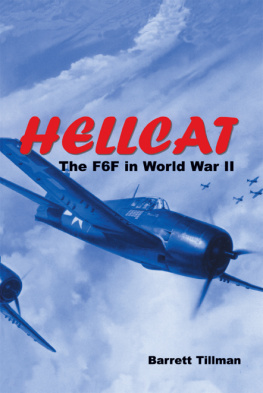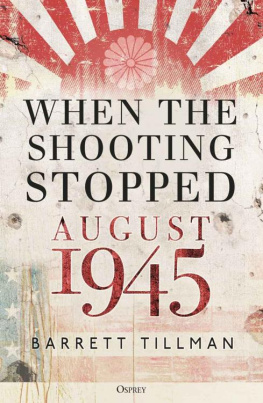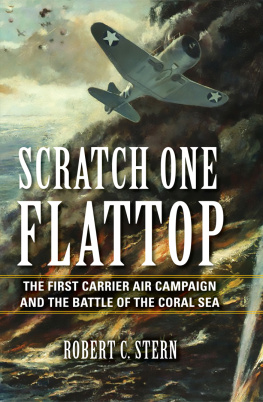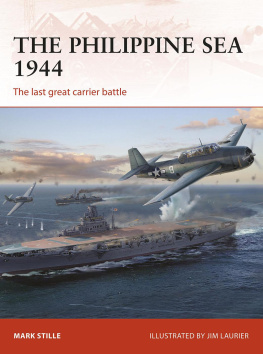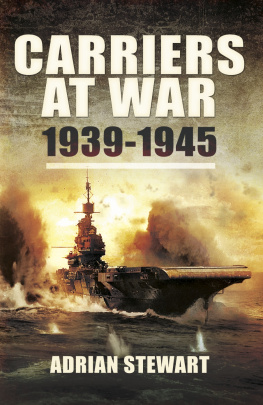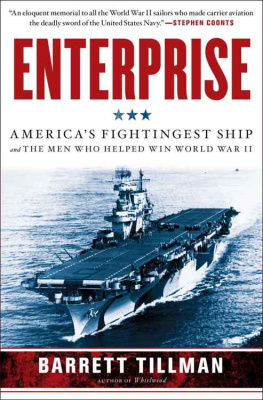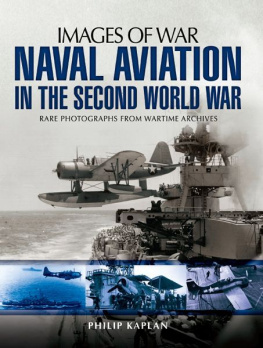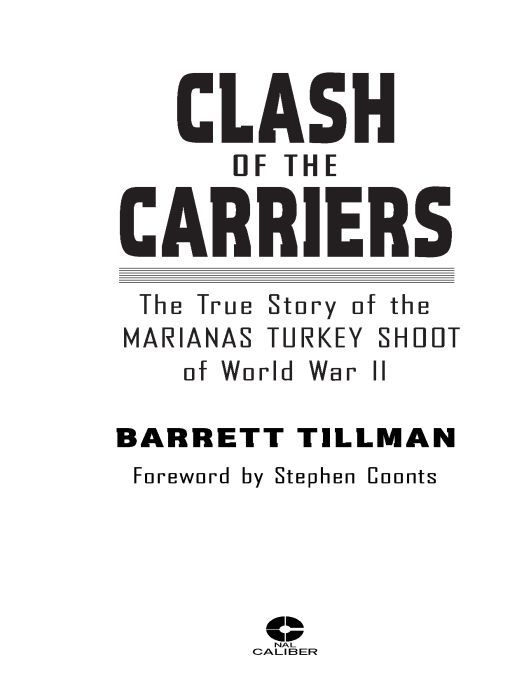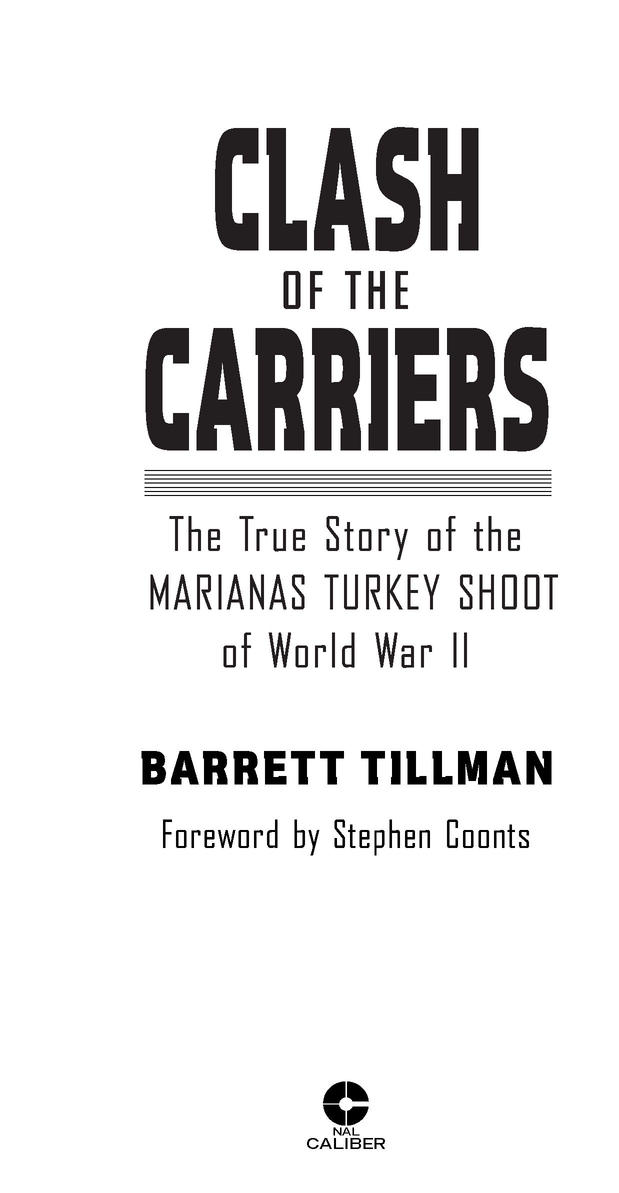Table of Contents
Praise forClash of the Carriers
Tillman, a longtime master of Pacific War naval history, has skillfully combined a wealth of research into an unprecedented look into both sides of this pivotal sea battle....Tillmans narrative gives near-definitive coverage of its subject, from the usual view from the cockpit to less common perspectives from the command plotting station, the deck of an oiler engaged in underway replenishment, the bowels of the engine room, or a submarine periscope.
Jon Guttman, American Fighters Ace Bulletin
In this superb work, the greatest naval air battle of all time finally receives the meticulous and comprehensive treatment it deserves. Whether you seek the view from the canopy or the sharp-eyed critique, Barrett Tillman, with unmatched command of the subject, delivers both in spadesand for both sides. His heroes are the aviators, whatever the uniform they wore, and he illuminates more warts on the U.S. side and the rare gems for the Japanese previously ignored or obscured. Richard Frank, author of Guadalcanal and Downfall
I saw the war from the deck of a battleship, so I cannot render an aviators view. But I can certainly recommend Barrett Tillmans definitive work on the subject. It does not replace the efforts of Admiral Morison, but amplifies them in a manner both instructive and entertaining. Lt. Col. Jeff Cooper, USMCR, USS Pennsylvania, 1944
With the analytical ability of a successful cold-case detective, and the flair of a gifted storyteller, Tillman reconstructs the famous battle as seen through the eyes of combatants, both American and Japanese. This gives balance and fairness, something missing in past histories, which tended to be one-sided.
Henry Sakaida, author of Winged Samurai and Gendas Blade
Barrett Tillman is the best contemporary writer on U.S. naval aviation. The Marianas Battle was the ultimate carrier-versus-carrier battle. Putting them together is the formula for an outstanding volume.
Norman Polmar, author of Aircraft Carriers
For Jig and Ginger and Alex and Kay
FOREWORD
ONCE UPON A TIME carrier decks were straight, Grummans had tail-wheels, and Pratt & Whitneys had props. In those days of yore, before free trade and NAFTA and the new world economy, America was the arsenal of democracy. She built her own ships, planes, guns, bombs, beans, bullets, uniforms, and electronics, and could, within three years of the declaration of war, field the largest, best-equipped, most modern military machine on the planet, one capable of fighting simultaneous wars in Europe and the Pacific and winning them both. Once upon a time...
In June 1944, the Japanese brought nine aircraft carriers to the sea battle off the Mariana Islands in the western Pacific; America brought fifteen, eight of which were small, Independence-class light carriers. The battle was a total rout, a disastrous defeat for the overmatched, outnumbered Japanese, who lost a third of their carriers and 90 percent of the airplanes their ships brought to the fray. Their planes were shot out of the sky like... well, like turkeys... by better-trained American pilots flying better, faster, more technically advanced aircraft. This sea battle marked the first time that Japan felt the full weight of Americas economic, population, and industrial superiority, which had in three short years been translated into an amazing military advantage that would, within fifteen months, leave Japan prostrate and in ruins.
The world has changed profoundly since 1944. For better or worse, American politicians have chosen to lower trade barriers that once protected domestic industries that paid living wages in peacetime and produced critical materials in times of war and national emergency. The American textile industry is now dead; the corpse was sent to India and China. The American steel industry is on its last legs. The American military carries pistols made in Italy. The only American shipbuilding concerns make U.S. Navy ships, and are not getting enough work to stay in business. No merchant ships are constructed in this country anymore. The remaining two American automobile companies face fierce competition from every automobile company on earth, yet are burdened with pension and health care obligations that will, one suspects, ultimately force them into bankruptcy, the same fate that has befallen the nations legacy airlines. Today every American manufacturer is forced to outsource jobs, shipping them overseas to stay competitive. (Amazingly, an increasing number of hospitals are having their medical X-rays read on the cheap in India. How the hospitals will have the X-rays interpreted if the Internet goes down is something that hospital administrators dont talk about.)
It is always a mistake to plan the next war based upon the last. In the wars of the future, it is hard to see how fleets such as those that existed during World War II can be brought into being by current national economies, or how they could contend in battle upon the oceans of the earth as independent military entities.
Aircraft carriers are still with us, although one suspects they too are on the cusp of becoming obsolete. Equipped with jet fighter and attack airplanes, they control vast areas of ocean... yet since World War II they have been asked repeatedly to project their power ashore. That task they do well, at a tremendous cost in manpower and treasure. In fact, carrier airplanes have become so expensive that one type after another is currently scheduled for retirement, not to be replaced. The ships will not stay in service without airplanes.
I wish to leave you with a few questions: If America is ever again forced to fight a large-scale conflict that lasts more than a month or two, where are the electricians, welders, and steel going to come from to build more ships? Where will we get tanks, uniforms, rations, and weapons to equip our troops to fight our battles? Who will build the planes to launch and fight from aircraft carriers, if we still have any of those? And finally, where is the fuel going to come from to power the ships and planes and tanks?
Once upon a time we had all these assets. Once upon a time America was the arsenal of democracy that could vanquish tyranny. Once upon a time Americas people believed that they had a duty to help make the world a safer place for democracy and the rule of law. Once upon a time...
Perhaps in the future we will not need what we have willingly surrendered or traded away in return for lower prices at Wal-Mart, lower prices at the automobile dealers and service stations, and lower taxes. At any rate, we can certainly hope so.
As you read Barrett Tillmans excellent work on the Marianas Turkey Shoot, reflect upon the dazzling courage and profound determination of those World War II naval airmen, pilots, and aircrew alike. Navigation consisted of a running dead-reckoning plot on a board each pilot carried on his lap, with the last-known position being the carrier from which he launched. When, or if, he managed to navigate his aircraft to that watery spot where the ship hoped to be at recovery time, the ship might or might not be there. There were no inertial nav systems, no GPS, no computers, not even a TACAN or Omni to home in upon.
If the aviator were shot down or his plane malfunctioned, he went into the great wide ocean, there to drown immediately or die slowly of exposure. Or become a meal for a shark. In that pre-helicopter age, finding lost airmen was haphazard at best, and no one expected the war to stop while a ship or ships went looking. There were no emergency transponder squawks, locator beacons, or handheld radios. Many Navy pilots and aircrewmen launched from carriers and were never heard from again.


